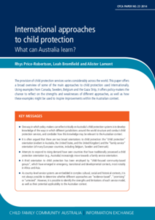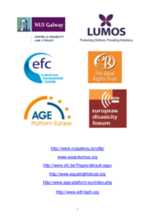

Displaying 351 - 360 of 422
This systematic review published by the Campbell Collaboration reviewed controlled experimental and quasi experimental studies in which children removed from the home for maltreatment and subsequently placed in kinship care were compared with children placed in non-kinship foster care for child welfare outcomes in the domains of well-being, permanency, or safety.
This online resource provides an overview of research, conducted by the European Union Agency for Fundamental Rights (FRA), on national child protection systems in the 28 European Union (EU) Member States.
This paper offers a broad overview of some of the main approaches to child protection used internationally. Using examples from Canada, Sweden, Belgium and the Gaza Strip, it offers policy-makers the chance to reflect on the strengths and weaknesses of different approaches, as well as how these examples might be used to inspire improvements within the Australian context.
Cet article porte sur l’analyse de trois configurations institutionnelles de la protection de l’enfance : celle en place au Burkina Faso, en Belgique et au Québec. Pour chaque configuration, le texte explore les transformations qui ont marqué le passage de la prise en charge exclusive de l’enfant par la famille vers la présence accrue de l’État et la manière dont la Convention internationale des droits de l’enfant de 1989 a influencé ce passage.
This article closes a special edition focused on the state of child protection in 16 countries chosen to represent very different cultural contexts, historical backgrounds, and social welfare systems with special attention to out-of-home care placements, principally family foster care and residential care, though several aspects related to adoption were included as well.
This article reviews the history and development of out-of-home care services in Germany and the Netherlands comparing trends and numbers.
This literature review by the Rees Centre for Research in Fostering and Education at the University of Oxford was undertaken to identify the ways in which carers’ children might be more effectively prepared and supported when their families are fostering.
This joint memo was issued by a group of European organizations to clearly state their belief that the draft language on community living in the proposed EU Structural Funds Regulations should be amended to enhance the effect and to better advance the rights of children, persons with disabilities, and older people.
En France, environ 273 000 mineurs sont pris en charge par les services de protection de l'enfance des conseils généraux et, parmi eux, environ 134 000 sont placés hors de leur milieu familial, en famille d'accueil ou en établissement, à la suite de décisions administratives ou judiciaires. Ces chiffres sont en augmentation depuis plusieurs années et le nombre de mineurs placés en France est, en proportion, supérieur à celui de nombreux autres pays européens.
Lorsque le maintien de l'enfant dans son milieu familial n'est pas possible, le mineur est à la demande de ses parents ou sur décision judiciaire, pris en charge par le Département. Plusieurs solutions peuvent être envisagées pour l'enfant, comme par exemple le placement en famille d'accueil.





